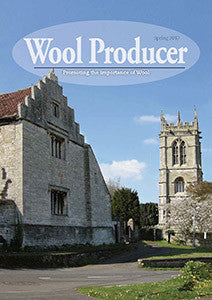A 16th century wool merchant’s home
 Extract from the Wool Producer Spring 2017
Extract from the Wool Producer Spring 2017
Ellys Manor House
A 16th century wool merchant’s home
We have mentioned in the past the ‘wool churches’ of the south east England, built by medieval wool merchants, but until recently have not heard of any merchant’s houses. We have assumed that these have either been destroyed or altered to such an extent that they are no longer recognisable. However, a chance meeting, just before Christmas at the Celebration of British Livestock, directed us to a house which gives a good indication of the wealth accrued by the 14th to 16th century wool merchants.
 In medieval England wool was big business. There was an enormous demand for it from the weavers in Flanders, and anyone who had land, from the peasants to the Lords of the Manor, raised sheep. The English did make cloth, but it was mainly for domestic use; very little was exported. It was the raw wool, reputed to be the best in the world at that time, which became the driving force of the English economy and the major source of income for the Crown. Even today the Lord High Chancellor sits on a large square bag of wool known as The Woolsack, a reminder that wool used to be the main source of England’s income.
In medieval England wool was big business. There was an enormous demand for it from the weavers in Flanders, and anyone who had land, from the peasants to the Lords of the Manor, raised sheep. The English did make cloth, but it was mainly for domestic use; very little was exported. It was the raw wool, reputed to be the best in the world at that time, which became the driving force of the English economy and the major source of income for the Crown. Even today the Lord High Chancellor sits on a large square bag of wool known as The Woolsack, a reminder that wool used to be the main source of England’s income.
As the wool trade increased the great landowners, including Lords and Bishops, counted their wealth in the numbers of their sheep. Large tracts of land, especially in the north, were owned by monasteries. The wool produced was, of course, taxed by the King.
Over time the large land owners developed direct links with the manufacturers but the smaller producers still relied on local wool merchants. The single-masted ‘cogs’, developed by the merchants of the Hanseatic League to carry goods along the coasts of Northern Europe, filled the ports. To understand the organisation of the wool trade we must go back to the reign of Edward I who first realised how much revenue he could make from the trade.
To understand the organisation of the wool trade we must go back to the reign of Edward I who first realised how much revenue he could make from the trade.
Realising how valuable this revenue was Edward III went to war with France partly to protect the trade with Flanders. After Calais was taken in 1347, 26 traders were incorporated into the ‘Company of the Staple of Calais’ and in exchange for its cooperation in payment of taxes, the company was granted a total monopoly of wool exports from England. Flemish and Italian wool merchants were familiar figures in the wool markets of England, ready to buy the bales of wool which were then transported to English ports such as Boston, King’s Lynn and London.
Download the complete article by clicking here...

 Extract from the Wool Producer Spring 2017
Extract from the Wool Producer Spring 2017

